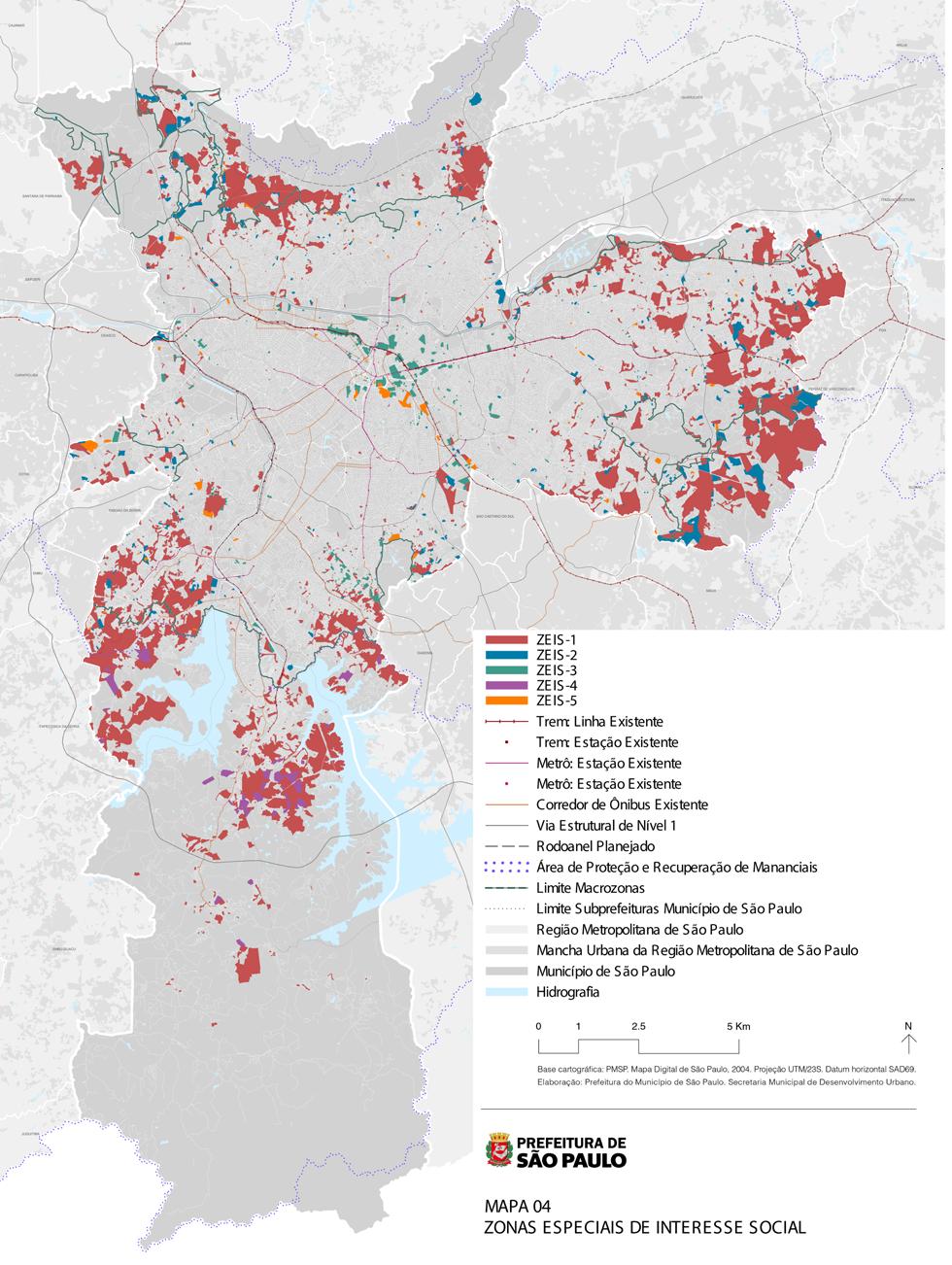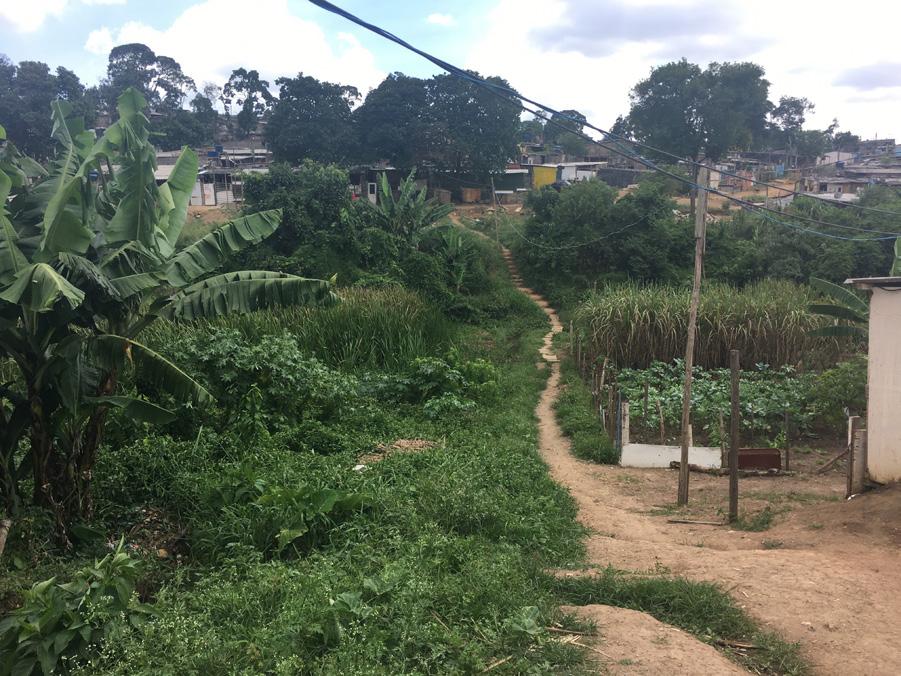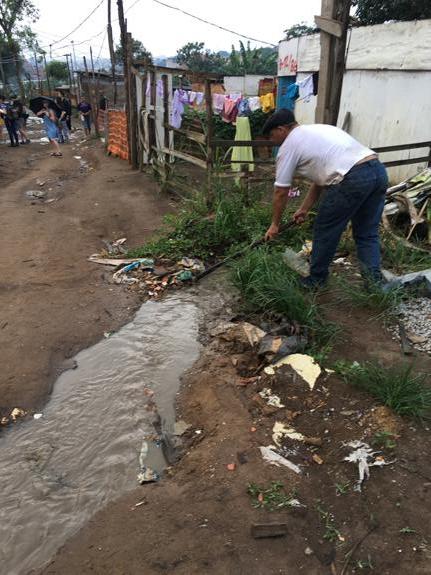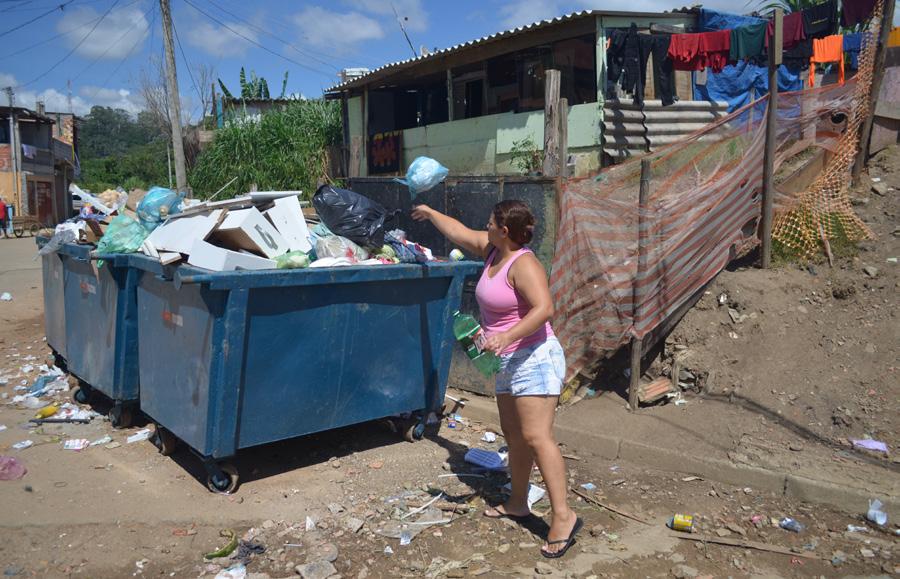
5 minute read
Housing, Zoning and Tenure Security
The São Paulo Metropolitan Region faces ongoing crises of housing deficit and lack of tenure security. As of 2001, Congress passed a city statute enabling the social function of land in an effort to combat speculation and idleness. Special Zones of Interest (ZEIS) are another mechanism to guarantee housing rights to those living in informal settlements.
22 (previous) Construction Debris After Demolition and Relocation of a House in the Area of Environmental Protection
23 (left) Areas of Social Special Interest, Strategic Master Plan São Paulo Prefeitura.
The São Paulo volume produced by the Taubman College Team explains that Brazil has been undergoing a long process of advocacy and implementation of new urban laws, policies, and programs, known as the urban reform movement. For the first time, the 1988 Federal Constitution of Brazil included a chapter on urban policy. Most notably, the principle that urban property must fulfill a social function became constitutional law.
Thirteen years later, The City Statute (Law No. 10,257 of 2001) passed Congress as the enabling legislation for the constitutional mandate.
The City Statute provides general guidelines on how urban land can fulfill its social function. Social function is fulfilled when urban property “meets the fundamental requirements of organizing urban city growth “…which are set forth in the Master Plan, ensuring that the needs of citizens are met with regard to quality of life, social justice and the development of economic activities” (Carvalho and Rossbach, 2010, p. 30).
The social function of urban property also aims to combat land speculation and idleness (Rolnik, 2013 and Fernandes, 2007), via several instruments, such as progressive taxation of idle land and compulsory land parceling. Brazilian law through its constitutional principles, enabling federal legislation, and international treaties adherence, considers forced evictions a violation of human rights and the right to the city. Therefore, Brazilian law is intended to ensure that municipalities, like São Paulo, use planning to confront injustices regarding land occupations (Carvalho and Rossbach, 2010). The 1988 Federal Constitution and the City Statute establishes different types of tenure security legal tools for public and private property (Macedo, 2007). Adverse possession is a tool available for informal dwellers occupying private property. Nevertheless,
24 ZEIS Categories, Secretaria Municipal de Urbanismo e Licenciamento. (2017). Ocupação Anchieta residents cannot file an adverse possession lawsuit because, Instituto Anchieta Grajaú (IAG) filed eviction claims within the first few months of occupation. Occupation dwellers have not occupied the land for five consecutive years without contestation from property owners, as the Federal Constitution requires.
The goal of the toolset for tenure security is to find other ways to legitimize ownership without formally selling and purchasing land as is seen in the formal land market. The mechanism for public land tenure security is Concessão de Direito Real de Uso (“real right to use concession”). Concessão de Direito Real de Uso (CDRU), protects squatter families through a lease contract, usually spanning 50 years. Under CDRU, families occupying public land are permitted to remain on the parcels where they built their house or transfer this right to someone else and apply it as collateral. At the same time, land is protected from speculation.
For private land, usucapião coletivo (collective adverse possession) is one tenure security mechanism that allows multiple urban land occupants to form a group, or “condominium association,” that can work to increase legal actions to obtain rights over land. The City Statute has enabled municipal governments to use planning tools to ensure land fulfills a social function and provides tenure security. These tools include Solo Criado (Transfer of Development Rights) and Zonas Especiais de Interesse Social (Special Zones of Social Interest) (ZEIS). It should be noted that the perception of tenure, opposed to actual legal proof, is sometimes more highly regarded and formal legal tenure does not necessarily result in improvements (Macedo, 2007).

25 The Forested Creek Area in Ocupação Anchieta.
Special Zones of Social Interest is another important mechanism to guarantee the housing rights of the population living in informal settlements. These special zoning districts have specific standards to guarantee the current and future availability of social housing. The core concept of ZEIS entails the legal recognition of the “right to use” when “right to property” is nonexistent and unattainable. The long-term objective of ZEIS is to regularize the area and provide legal titles (Macedo, 2007). Ocupação Anchieta is located in a ZEIS district, specifically ZEIS 4. The Floor Area Ratio (FAR) requirement for a ZEIS 4 is two, making ZEIS 4 the lowest density ZEIS zoning district. The FAR of the highest density ZEIS district is 4 (Montandon, 2017). Additionally, ZEIS 4 areas consist of undeveloped land in headwater or environmentally protected areas. They are suitable for Habitação de Interesse

26 Resident Pushes Trash Out of the Way of Stormwater Runoff in Ocupação Anchieta. Social (Social Interest Housing) in order to house families relocated from risk or permanent preservation areas. The ZEIS 4 category can also be used to reduce population densities of ZEIS 1 zones in the same hydrologic sub-basin (subject to Lei de Proteção e Recuperação dos Manancias [Headwaters Protection and Recovery Law] (Ribeiro et al., 2015)
Given the fact that Ocupação Anchieta is situated in a City of São Paulo zoning district that permits human settlement for social housing and, at the same time, requires environmental protection, land values are low. Then, IAG acquired the land as a donation from a developer. Given the density restrictions on ZEIS 4, these zones are somewhat shielded from land speculation. Nonetheless, zoning in Brazil as in many places can change and land price can increase.
Located in the Occupation, the Minas (seasonal creek and natural springs) area is the most environmentally sensitive because of the water pollution. This environmental damage is aggravated by the lack of basic infrastructure. Land occupiers and clusters of land occupiers have developed distinct ways to discharge wastewater and solid waste in the Occupation. Although almost all residents have a toilet inside their home, the Occupation’s sewage system varies. Of the sewerage the Taubman College Team was able to observe, 19% of households use septic tanks and the rest of the site discharges directly into water bodies (assuming pipes discharge directly into onsite water bodies), except for a small portion of households that are informally connected to the municipal system.
The waste management system is deficient as well. The Taubman College Team observed dumpsters that were over capacity

27 Resident Dumping Trash.
each day; litter in the roads, trash in the water, and waste dumped and burned in open space and residents’ yards.
Therefore, Taubman College Team’s goal is to embrace this housing and environmental conflict in the Occupation. Through the strategies proposed, we hope to give the Ocupação Anchieta Association the tools that they can use to reduce their environmental impact. As well as, advance their living conditions so residents can have an improved quality of life and remain in their homes without threats of eviction.






